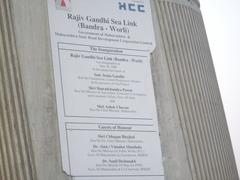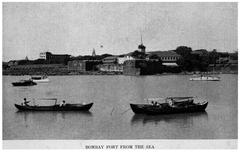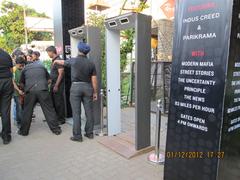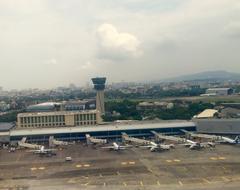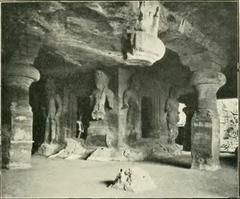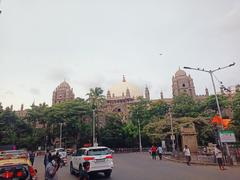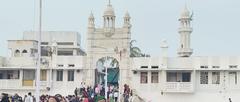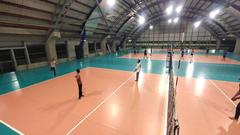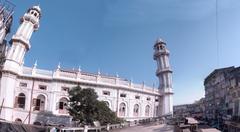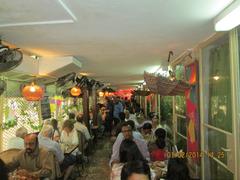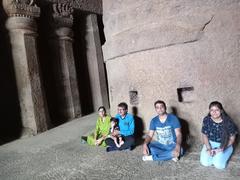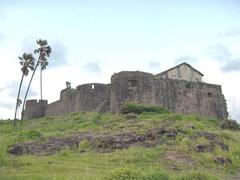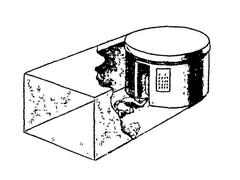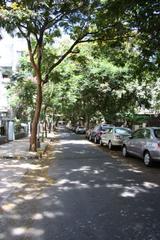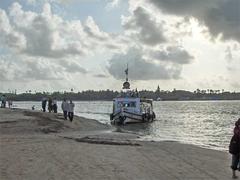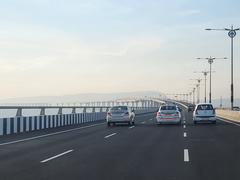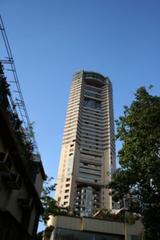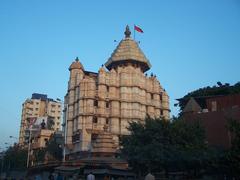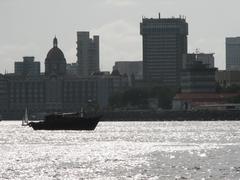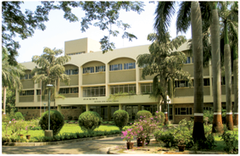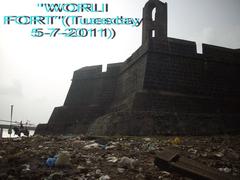Marine Drive Mumbai: Visiting Hours, Tickets, and Historical Sites Guide
Date: 14/06/2025
Introduction: Marine Drive Mumbai—An Iconic Seafront Promenade
Marine Drive, often referred to as the “Queen’s Necklace” for its glittering arc of night-time lights, is among Mumbai’s most treasured landmarks. Spanning 3.6 kilometers along the Arabian Sea, this elegant crescent-shaped boulevard is both an architectural marvel and a vibrant social hub. Famed for its collection of Art Deco buildings—the second largest after Miami—and its role in Mumbai’s historical and cultural evolution, Marine Drive epitomizes the city’s cosmopolitan spirit and enduring resilience. Open 24/7, accessible, and lined with palm trees and panoramic sea vistas, Marine Drive remains a must-visit for locals and travelers alike (The Urban Anecdotes; Thrillophilia; Treebo; TripSavvy).
Table of Contents
- Introduction
- Historical Background
- Visiting Marine Drive: Practical Information
- Frequently Asked Questions (FAQs)
- Timeline of Key Milestones
- Enduring Legacy
- Summary and Call to Action
- References
Historical Background
Early Origins and Land Reclamation
Marine Drive’s history is deeply rooted in Mumbai’s transformation from seven islands into a dynamic metropolis. The British colonial administration initiated the Back Bay Reclamation Scheme in the late 19th and early 20th centuries to reclaim land from the Arabian Sea, expanding the city’s urban footprint. While only about 440 acres were ultimately reclaimed, this ambitious engineering feat laid the foundation for what would become Marine Drive. Construction began in 1915 at Girgaum Chowpatty (formerly Kennedy Sea Face), and by the mid-1930s, the foundational promenade was largely complete (The Urban Anecdotes; Art Deco Mumbai; Zee Zest).
Architectural Development: The Art Deco Influence
The 1930s and 1940s marked a surge in construction along Marine Drive, with the city’s elite commissioning residences and hotels in the Art Deco style. Defined by streamlined facades, geometric motifs, pastel hues, and curved balconies, these buildings embraced international trends while reflecting Mumbai’s unique cultural identity. Today, Marine Drive boasts one of the world’s largest Art Deco ensembles, many of which are UNESCO World Heritage sites (TripSavvy; Treebo). Notable examples include Shiv Shanti Bhuvan, Motabhoy Mansion, Swastik Court, and nearby landmarks like Eros Cinema.
Strategic & Social Significance
Initially designed for practical purposes—serving as a coastal defense barrier and a modern arterial road—Marine Drive’s name was officially changed to Netaji Subhash Chandra Bose Road. Philanthropists like Bhagojisheth Keer and Pallonji Mistry played key roles in its construction, with completion in 1940. Following independence, Marine Drive evolved from a strategic project into Mumbai’s beloved public promenade, drawing diverse crowds for recreation, socialization, and events (Piramal Aranya; Wikipedia; Trip101).
The “Queen’s Necklace” and Cultural Identity
Marine Drive’s famous C-shaped curve stretches from Nariman Point to Girgaum Chowpatty. At night, its arc of streetlights creates the glittering “Queen’s Necklace” effect—a symbol of Mumbai’s glamour and resilience. In the post-independence era, Marine Drive became synonymous with the city’s nightlife, Bollywood film culture, and vibrant public life, further cementing its place in Mumbai’s collective imagination (Zee Zest; Mumbai7).
Urban Challenges & Conservation
Marine Drive’s endurance is a testament to robust engineering—requiring its first major repairs only in 2012 after more than seven decades. The promenade is protected by over 6,500 concrete tetrapods that shield it from the Arabian Sea’s waves. However, the city’s rapid development poses challenges, including congestion, real estate pressures, and the need to preserve open spaces. Conservation efforts and government regulations strive to maintain Marine Drive’s iconic skyline and heritage character, even as new projects like the Mumbai Coastal Road alter the urban landscape (Art Deco Mumbai; The Urban Anecdotes).
Notable Landmarks and Social Evolution
Landmarks along Marine Drive include the Taraporewala Aquarium, Saifee Hospital, and luxury hotels that have hosted celebrities and dignitaries. Initially the domain of the elite, the promenade has become a truly democratic space, open to all and hosting festivals, marathons, and public celebrations (TripSavvy; Piramal Aranya; Mumbaimetrotimes).
Visiting Marine Drive: Practical Information
Visiting Hours
- Open: 24 hours a day, 7 days a week.
- Best Times: Early morning (6–9 AM) for peaceful walks and evening (5–9 PM) for sunset and night-time “Queen’s Necklace” views.
Tickets and Entry Fees
- Entry: Free of charge; no tickets required.
Accessibility
- Promenade: Wheelchair-friendly with ramps and smooth pathways.
- Public Transport: Easily accessible via Churchgate and Marine Lines railway stations (Western Line), multiple bus routes, and taxis.
- Parking: Limited, especially at peak and evening hours—public transport is recommended.
- Facilities: Benches, public toilets, street lighting, and food stalls available along the promenade.
How to Get There
- By Train: Churchgate (approx. 1 km) and Charni Road (approx. 2 km) stations.
- By Metro: Girgaon Metro Station (Line 3), roughly 2 km away.
- By Bus: Several BEST bus routes have stops along Marine Drive.
- By Car/Taxi: Major arterial road with frequent taxi and auto-rickshaw access.
Nearby Attractions & Guided Tours
- Girgaum Chowpatty Beach: Street food hub and festival hotspot.
- Taraporewala Aquarium: India’s oldest public aquarium.
- Nariman Point: Business district with luxury hotels and cultural venues.
- Art Deco Building Walks: Guided and self-guided tours available.
- Malabar Hill: Panoramic city and seafront views.
- Gateway of India, Chhatrapati Shivaji Maharaj Vastu Sangrahalaya, Mani Bhavan, Hanging Gardens: All within a short drive.
Frequently Asked Questions (FAQs)
Q: What are the visiting hours for Marine Drive, Mumbai?
A: Open 24/7, with mornings and evenings being most popular for pleasant walks and stunning views.
Q: Is there an entry fee or ticket required?
A: No, Marine Drive is a public promenade with free entry.
Q: Is Marine Drive wheelchair accessible?
A: Yes, most of the promenade is accessible, though some heritage buildings may have limited access.
Q: Are guided tours available?
A: Yes, several local operators offer walking tours focusing on Art Deco architecture and history.
Q: Can I swim at Girgaum Chowpatty Beach?
A: Swimming is not recommended due to water quality and occasional jellyfish (fromheretoindia.com).
Q: What is the best time of year to visit?
A: October to February offers the most comfortable weather; the monsoon (June–September) brings dramatic sea views but slippery paths.
Timeline of Key Historical Milestones
- 1860s: British begin city expansion via land reclamation.
- 1915: Construction begins at Kennedy Sea Face (Girgaum Chowpatty).
- 1930s–1940s: Art Deco building boom and completion of the boulevard.
- 1947: Marine Drive becomes a public promenade post-independence.
- 2012: First major repairs and upgrades after 72 years.
- 2018: Art Deco ensemble inscribed as a UNESCO World Heritage Site (The Urban Anecdotes; TripSavvy).
Enduring Legacy
Marine Drive’s journey from colonial engineering marvel to a UNESCO-recognized heritage precinct mirrors Mumbai’s growth, diversity, and dynamism. It is both a vital “lung” for the city and a living museum of architectural and cultural history (Art Deco Mumbai; Trip101). Conservation efforts continue to protect its unique character amid rapid urban changes.
Visitor Experience: Activities & Tips
- Walk, Jog, Cycle: Best enjoyed during early mornings and evenings.
- Street Food at Chowpatty: Savor Mumbai’s favorites like bhel puri, pav bhaji, and kulfi.
- Photography: Sunset and night-time “Queen’s Necklace” views are spectacular.
- Yoga & Meditation: Popular among locals at sunrise.
- Festivals: Don’t miss Ganesh Chaturthi immersions or the Mumbai Marathon.
- Dining: Iconic eateries and rooftop venues at Nariman Point offer stunning vistas.
- Safety: Well-lit and patrolled, but always keep your belongings secure.
Summary and Call to Action
Marine Drive embodies Mumbai’s historical evolution, architectural grandeur, and vibrant everyday life. Open 24/7 with no entry fee, accessible by all, and surrounded by cultural, culinary, and leisure attractions, it offers an unforgettable window into the city’s past and present. Whether you are a history enthusiast, architecture lover, or a traveler seeking scenic beauty, Marine Drive promises an experience that captures the essence of Mumbai (TripSavvy; Treebo; The Urban Anecdotes; mumbai.org.uk).
Plan your visit today:
- Download the Audiala app for guided audio tours, travel tips, and offline maps.
- Explore nearby Mumbai historical sites and Art Deco architecture.
- Follow us on social media for event updates and exclusive content.
References
- The Urban Anecdotes: Pride of Mumbai—Marine Drive
- Treebo: Marine Drive Mumbai—Visiting Hours, Tickets, and Architectural Significance
- Mumbai.org.uk: Marine Drive—Visiting Hours, Attractions, and Travel Tips
- Thrillophilia: Marine Drive—Visiting Hours, Attractions, and Travel Tips
- Zee Zest: Marine Drive Mumbai—Visiting Hours, Tickets & Historical Guide
- Tusktravel: Exploring Marine Drive Mumbai—Your Comprehensive Guide
- TripSavvy: Mumbai Marine Drive—The Complete Guide
- fromheretoindia.com: Travel to Mumbai—Marine Drive
